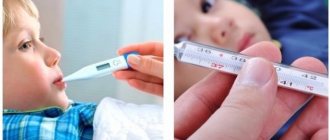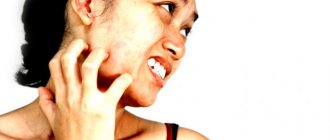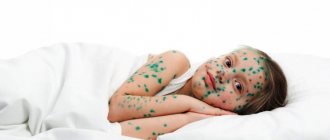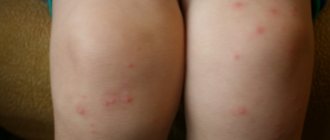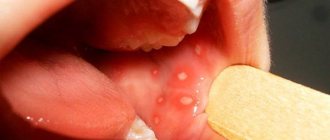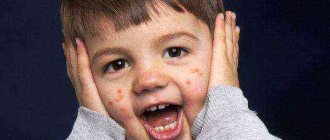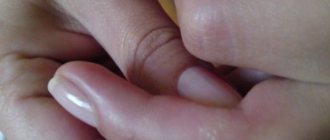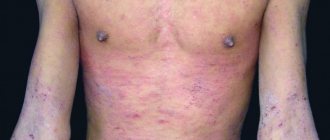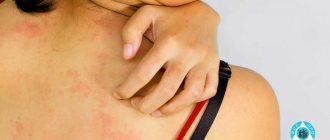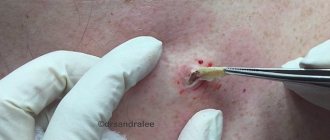Diaper dermatitis, as the name suggests, is diagnosed in babies who do not yet know what a potty and toilet are. The risk of the disease is especially high in girls and boys with sensitive skin.
This disease also occurs in adults who have long since left the “diaper” state, but for various reasons are forced to use diapers.
According to medical statistics, almost 60 percent of infants suffer from this skin disease to one degree or another.
However, the argument “it’s okay, it happens to everyone” is not suitable: if a mother looks at a photo on the Internet of what a tiny sore bottom looks like, on which there is not a single “living place” left, she will make every effort to prevent this from happening to her baby.
Symptoms
Diaper dermatitis (experts also call it “erythema of the buttocks”) according to the ICD-10 classification of diseases has code L22. The symptoms of the disease are clear even to a non-specialist:
- inflammation of the buttocks and genitals;
- redness and peeling;
- in difficult cases – weeping areas, wounds, pimples;
- painful sensations when touched;
- burning, itching;
- general anxious state – tears, whims.
An important point: the skin is inflamed in those places where it comes into contact with diapers and diapers.
If similar signs appear in other places (for example, on the cheeks, behind the ears), there is a high probability that we are not talking about diaper dermatitis, but about some other disease. This means you need to seek help from a doctor.
Medical assistance cannot be avoided even if parents are unable to cope with the problem on their own: neglected diaper dermatitis can turn into chronic or serve as an impetus for some other, more serious skin disease.
In bottle-fed infants, the skin near the anus requires special control, since the stool of such babies has a stronger alkaline reaction, and the discharge dangerously irritates the baby’s delicate skin.
Video with useful tips for parents from the Union of Pediatricians of Russia:
Why do red papules appear?
The sizes of such nodules can be very diverse, but if the diameter of the rash exceeds 10 mm, then they are already called plaques.
Causes of papulomatosis:
- infectious diseases of general origin and skin;
- hypertrophic changes in the layers of the dermis;
- neoplasms of varying degrees of malignancy.
Doctors distinguish red formations of inflammatory and non-inflammatory nature. The first ones are filled with purulent contents and can go away on their own. The second ones are dense, consist of dermal tissues, and have their own vascular network. Spontaneous remission is impossible.
Causes
Babies are easy prey for this disease: their skin is very delicate, their immunity is not strong enough, and their thermoregulation functions are still imperfect.
In addition, many children have an allergy or a predisposition to it, which makes the skin even more vulnerable.
The immediate causes of diaper dermatitis are as follows:
- “greenhouse effect” - high temperature and humidity under the diaper;
- lack of air access to the skin under diapers and nappies;
- rubbing them, as well as clothes, on the body (this happens especially often if parents made a mistake with the size of the diaper or put it on incorrectly);
- the presence of various irritating components in urine and feces (for example, ammonia, salts);
- poorly selected creams and powders that cause inflammation on the baby’s skin;
- infection by pathogenic microorganisms, fungi.
According to experts, hygiene is the most important thing in caring for your baby..
The disease will not be long in coming if parents keep the baby in wet diapers for a long time, rarely change diapers, do not bother washing clothes, but only dry them, and do not regularly organize water treatments for the child.
Stages
In a newborn, dermatitis can go through three stages of development.
The first (it is considered the mildest) consists of minor redness from diapers, affecting limited areas of the skin.
The second stage is characterized by abrasions, diaper rash on the butt and groin, and in difficult cases, infection by pathogens.
The third stage is the recovery period. If complications and infection are avoided, and the treatment is chosen correctly, the child recovers quickly, diaper rash is cured within three days.
The main symptoms and treatment of toxicerma are described in this article. Find out more!
You will find a list of emollients for atopic dermatitis in children in this material.
Nutrition for seborrheic dermatitis on the head (diet menu) is discussed here: https://udermatologa.com/zabol/derm/seb/menyu-diety-pri-seboree-kozhi-golovy-i-litsa/
Kinds
There are several types of diaper dermatitis, each of which requires a special approach to treatment.
Bacterial
The bacterial form of the disease is classified as a complication that occurs in a child suffering from diaper dermatitis.
In this case, the baby’s body is attacked by various bacterial infections; the doctor identifies the symptoms of these diseases and selects the most effective treatment.
Candida
Inflammation is concentrated in the groin and perineal area. The color of the affected surfaces is bright red.
This type of dermatitis is weeping, although there are also dry, inflamed, scaly areas.
If you do not start treating the disease in time, its pathogens can penetrate the body, complicating the condition of the little person.
Candidal diaper dermatitis requires specific therapy; doctors prescribe Ketoconazole, Miconazole and others ointments to the patient.
It is impossible to select funds without the participation of a pediatrician, as they may not be effective enough. But even in this case, you can’t count on quick treatment; it can last a month.
Fungal
When, after 3-4 days, treatment of diaper dermatitis remains ineffective, the inflammation does not go away, there is a high probability that the baby has fungal diaper dermatitis.
If such a diagnosis is made, the doctor prescribes antimycotic (antifungal) medications to the small patient. Clotrimazole and nystatin ointment may be recommended.
Warning against self-medication, doctors remind that antibiotics have no effect on yeast fungi.
If in a situation with fungal diaper dermatitis you rely on this type of medication, the disease will begin to progress, the inflammation will intensify, sores and blisters will appear.
Intertrigo
This type of dermatitis is caused by skin rubbing against skin. Light abrasions appear that become inflamed when they come into contact with urine.
This type of disease can be distinguished from others by the characteristic yellowness that covers the inflamed areas of the skin.
Impetigo
With this type of diaper dermatitis, which is considered staphylococcal, the skin on the thighs, buttocks and lower abdomen becomes inflamed.
The disease develops according to two scenarios: with the presence of blisters (bullous form) and without them, but with scars and yellowish crusts.
Diagnosis of infectious rashes
Typically, the disease is diagnosed through a routine visual examination by a dermatologist. However, in some cases, the papule is quite difficult to distinguish from other skin pathologies. In such situations, specialists write out referrals for a blood test, histological examination or bacteriological culture of the internal contents of the vesicles.
The papule is characterized by the following symptoms:
- thin top layer;
- presence of fibroblasts;
- presence of connective tissue;
- a large number of blood vessels.
Once the diagnosis is made, procedures are prescribed to remove the defect.
When diagnosing maculopapular rashes and nonvesicular rashes caused by viral infection, the palms and soles become predominantly affected, which is otherwise quite rare. Thus, for bacterial and fungal infections, immune diseases, as well as side effects on various medications, such a lesion zone is absolutely not typical.
An infectious rash in a child can accompany both acute and chronic diseases. Among acute pathologies, rashes most often manifest themselves as measles, chickenpox, scarlet fever and others, and among chronic pathologies - tuberculosis, syphilis and others.
At the same time, the diagnostic significance of the elements of the rash may be different. So, in one case, the diagnosis can be made based on characteristic rashes alone, in others, the elements of the rash become a secondary diagnostic sign, and in others, the rash is an atypical symptom.
Measles rash
Treatment of diaper dermatitis in children
First, a few general recommendations:
- if the dermatitis is weeping, drying ointments or powder will help;
- if wounds and cracks have formed at the site of redness, you need an ointment that accelerates the regeneration of the skin;
- To treat the inflamed surface, you cannot use both powder and cream at the same time;
- hormonal ointments cannot be used against diaper dermatitis (for example, such an effective remedy as Advantan is one of them);
- Regular air baths (they are strongly recommended by the famous pediatrician Komarovsky) lasting 10-15 minutes help very well.
Help of drugs
It is impossible to quickly cure diaper dermatitis without the use of medications - ointments, lotions, creams.
Before using them, a little preparatory work is carried out: they wipe the inflamed areas with a swab dipped in a healing decoction of chamomile, string, or some other medicinal plant, and then, to dry the skin, they organize an air bath for the baby.
The ointment and cream are recommended by the doctor, and his advice must be followed, since the difference in the effects of drugs on the body can affect the result of treatment - the doctor takes all these nuances into account.
Here's what is commonly used to treat diaper rash:
- Desitin – soothes inflamed skin;
- Sudocrem – prevents the appearance of diaper rash, rashes and treats them;
- Bepanten - heals damaged skin and restores its natural functions;
- Baneocin (in powder form) – effective as baby powder, heals weeping skin surfaces well;
- Clotrimazole - used as a therapeutic and prophylactic agent to avoid relapses;
- Zinc ointment - effectively treats the skin, but requires preliminary antiseptic treatment (Fukorcin, for example);
- Sinoflan ointment - has an antiallergic effect, soothes itching; More details on the instructions for using Sinaflan ointment can be found here;
- Chlorhexidine is a strong antiseptic with a prolonged effect;
- Candida (in the form of lotion) – used against fungus;
- D-Panthenol is an anti-inflammatory agent;
- Methylene blue (in the form of an alcohol solution) – disinfects the skin well, recommended for children over one year old.
Traditional medicine
Many parents, instead of smearing their baby’s bottom with ointments and creams, prefer to use folk remedies at home.
It is advisable to combine them with medications, having previously received approval from a doctor and making sure that the baby is not allergic to any of the natural components.
Here are possible treatment options:
- oat infusion for baths – a couple of tablespoons per glass of boiling water (can be used every day while bathing);
- ointment from celery and potatoes - the components are taken raw, equally, crushed in a blender (applied to the inflamed areas for 15 minutes, then removed with a damp swab);
- oak bark infusion - prepared over low heat (wipe skin pre-treated with soapy water).
Determining acne in a child’s groin, treatment and prevention
In the intimate area of children, various rashes occur quite often and, as a rule, the most common cause is allergies or prickly heat.
Today, acne in a child’s groin has become a common occurrence, since most parents use various types of diapers, wet wipes and other modern products when caring for small children, without following the rules for their use.
Of course, this is far from the only reason for the appearance of such a disorder; besides, acne in the groin can be observed not only in children.
Causes of acne in the groin of a child
Most often, such a disorder is observed in infants of the first year of life, and this is associated with improper or insufficient care.
Many parents, trying to make their lives more comfortable, put diapers on their baby and leave the child in them for the whole day, changing them only after defecation.
As a result, the skin is almost constantly without normal access to air, which, combined with the baby’s urine absorbed into the diapers, creates a kind of greenhouse effect and leads to irritation.
It is very important to use disposable diapers correctly, thoroughly cleansing the baby's skin when changing them, using mild baby soap and clean water, and not a variety of wet wipes. It is necessary to change diapers every 3-4 hours, as well as after defecation, treating the skin in the groin area with baby cream before putting them on.
Also, any substance used to impregnate or fill a diaper can cause a rash to appear in intimate places in infants, so you need to choose such hygiene products correctly, taking into account the characteristics of the baby’s body. The same applies to other baby care products, such as soap, various creams, lotions, powders, powders, as well as washing powders and conditioners used for washing clothes.
Pimples in the groin of a child 1 year of age or older can appear not only due to improper or insufficient care, but due to overheating of the body.
Very often, parents and other relatives, fearing for the baby’s health and trying to prevent possible colds, put on the child too many items of clothing or things made from fabrics that are inappropriate for the weather and season.
Clothing that is too warm causes the body to overheat, especially if the child is very active and is in constant motion while awake. Overheating of the body increases sweating, and the accumulation of sweat often leads to the appearance of rashes due to the development of prickly heat.
A common cause of rashes is the child wearing clothes made of low-quality and unnatural fabrics, in particular, with the addition of synthetics and other artificial fibers.
Synthetic fabrics very often cause irritation on the skin of children of different ages, so you should not skimp on children's clothing.
Also, the cause of the appearance of red pimples in the groin can be a common allergy, which occurs not only when in contact with household chemicals or fabrics, but also when consuming various allergenic foods or medications.
As a rule, in the groin area, acne in girls is usually localized on the external genitalia (on the surface of the labia), and if the disorder is left without the necessary treatment, vulvitis may develop at an older age, characterized by the appearance of numerous small ulcers and wounds on the skin . In boys, the rash usually begins to appear on the surface of the scrotum, gradually spreading to the surrounding skin.
In some cases, acne in the groin of a child can be associated with quite serious disorders and diseases, for example:
- With a bacterial or fungal infection;
- With allergic dermatitis;
- With the presence of pubic lice;
- With eczema or psoriasis;
- With various infectious diseases;
- With infectious diseases of the genitourinary system;
- With the presence of pathologies in the digestive system, in particular, with disruption of the gallbladder and liver;
- With diabetes and other hormonal problems.
An important point is that in children, rashes on different parts of the body, accompanied by intense itching, can be associated with ordinary stress, strong feelings or nervous strain. Therefore, you should not draw conclusions about the causes of the rash and try to treat the disorder yourself. This should only be done by a qualified doctor.
Types of acne in the groin of a child
Sometimes the cause of the rash can be assumed independently, but to confirm suspicions, you need to see a doctor and undergo an examination. An important point in diagnostics is a visual assessment of the rash, its appearance, size, location and color.
Red pimples in the groin of a child
In most cases, red rashes indicate dermatitis of various etiologies, including allergic or diaper dermatitis, or the appearance of prickly heat. If the rash is caused by lack of hygiene, rare changes of diapers, nappies or underwear, then multiple small pimples appear on the skin of the groin area, merging into red spots.
Watery pimples in the groin of a child are, in fact, the second stage of the development of dermatitis, in which the pathogenic elements burst, cause intense itching, cause pain and constant discomfort to the child. In place of burst pimples, crusts form. The danger of such a rash is that pathogens can get into the wounds, which will significantly worsen the situation.
With prickly heat, small red pimples appear in large numbers, but they are located singly, without merging into spots.
Also, red pimples can be a sign of an infectious disease such as measles, rubella, chicken pox, scarlet fever.
White pimples in a child's groin
White pimples in the groin area in children are those pathogenic elements that are not accompanied by signs of inflammation, redness, irritation, itching and other uncomfortable sensations.
In fact, these are ordinary papules that do not contain pus or other liquid inside.
The cause of such rashes is usually incorrect or insufficient hygiene of the groin area, infrequent changes of disposable diapers or diapers, infrequent water cleansing procedures, as well as the child wearing synthetic underwear.
In this case, you should not panic; you should simply change the principles of caring for your child, increasing the number of water procedures, changing his clothes and washing products.
Treatment of acne between the legs of a child
Certain methods of therapy always depend on the specific cause that caused the appearance of acne, and only a doctor can accurately determine it after examination and examination.
But at the same time, a number of independent measures should be taken, in particular, changing the brand of disposable diapers, changing them more often, while washing the baby with baby soap and treating the skin with cream.
Change the baby's clothes to items made of cotton fabrics, and for washing it is best to use liquid soap without dyes and fragrances that can cause an allergic reaction.
If there is severe itching, the doctor may prescribe the use of antiseptic ointments, in particular Fenistil (gel), Nezulin, Gistan, Boromenthol.
If the case is advanced and the rashes occupy a large area of the skin and are also very intense, the use of hormonal drugs and corticosteroids may be required.
For fungal skin infections, the doctor prescribes special products, for example, Miconazole, Sertaconazole or Nystatin, which should be applied twice a day to the affected areas of the skin after water cleansing procedures.
In some cases, it may require additional treatment of the affected skin with special antiseptic solutions, such as Miramistin, Chlorhexidine, Furacilin, hydrogen peroxide or baking soda solution.
For allergies and dermatitis of the allergic group, antihistamines are prescribed in tablet form or in the form of ointments. The choice of funds in this case is made only by the doctor, and he also determines the required dosage, which is always individual.
To treat rashes on the genitals, you can also use traditional medicine, in particular, decoctions of medicinal herbs, provided the child does not have an intolerance to them.
Decoctions and water infusions of medicinal herbs are usually used to wash the child, and the procedure must be carried out at least three times a day. To wash girls for medicinal purposes, it is recommended to use decoctions of sage, chamomile, oak bark, yarrow or St. John's wort.
For boys, a decoction or infusion of linden flowers, calendula, oak bark, string or bay leaves is more suitable for this procedure.
Source: //otprishchei.ru/raznovidnosti-vospalenij-na-kozhe/pryishhi-v-pahu-u-rebenka/
How to treat skin irritation from diapers in adults
Skin irritations are not uncommon in bedridden patients. They cope with them using both traditional methods, using decoctions of medicinal herbs, and medications.
For diaper dermatitis, ointments with lanolin and zinc oxide are used. Levomekol ointment, for example, is effective against bedsores, prickly heat, and diaper rash.
If you need to get rid of fungal infections, you can use Miconazole, Batrafen. Baneocin is effective in the fight against pathogenic flora.
Air baths are useful: you need to remove the patient's diaper and underwear, under which there are inflammations on the skin, and give the person the opportunity to lie down without them for a while.
And, of course, regular patient care and compliance with hygiene requirements are important.
The causes, symptoms and treatment of atopic dermatitis in children with folk remedies are presented in our publication.
The composition of the cream with hyaluronic acid Skin-Active, reviews of its use, as well as analogues can be found in the following material.
Causes of skin rashes
Rashes on the extremities always indicate the presence of some pathology. The reason for the appearance of papules can be very different:
- insect bites;
- allergic reaction to food, medications, pollen and other allergens;
- fungal infections;
- parasitic skin diseases;
- infection;
- viral pathogens;
- pathologies of internal organs and systems.
Papules on the extremities, both in adults and children, can cause a lot of trouble. In addition to aesthetic discomfort, rashes are often accompanied by unbearable itching. Scratching the tumors threatens the addition of a secondary infection, inflammation and suppuration of the problem areas. The consequences of an abscess are marks on the skin in the form of scars, cicatrices and pigmentation.
A timely visit to a specialist and making a correct diagnosis is the key to quickly and successfully getting rid of problems.
Treatment of papules can take from 2-3 days to several weeks. It all depends on the cause of the disease, intensity and neglect.
Allergic contact dermatitis can manifest as rashes on the legs in the form of redness and swollen indurations. Its symptoms are itching and the appearance of vesicles.
The latter burst when scratched and in their place erosions and ulcers form, which are accompanied by pain.
Red rashes in a child, localized on the wrist, the outside of the hands and feet, and on the fingers with severe itching, indicate a parasitic skin disease such as scabies. A characteristic sign of the presence of a pathogen is increased itching at night and a special type of rash.
Vesicles up to 3 mm in size are connected into tracks up to 2 cm long - scabies ducts. Children and adolescents are most often affected by the disease.
However, adults are no exception to such skin lesions. Itchy papules on the feet of children may indicate an allergy, most often to sweets and some fruits.
Such manifestations do not exclude the presence of fungal infections. In any case, you should see a dermatologist.
The appearance of erythema on the hands of children may indicate infectious diseases such as measles and scarlet fever. The cause may be various dermatitis, allergies, chemical burns, and physiotherapy.
The cause of small red nodular, bandless seals on the leg of adults may be a cold allergy. Visually, the pathology resembles urticaria, and when pressure is applied, the pimples turn pale. The papule is accompanied by pain and burning. The formations go away on their own and do not remain on the skin for more than a few days.
We recommend reading: What are white papules and why do they appear Chickenpox papules: causes and treatment methods Fibrous papule: treatment and prevention
Rashes in children are usually classified into three main groups: infectious, allergic, rashes after insect bites.
In most cases, the reasons for the development of papules lie in the following:
- Accumulation of infiltrate due to ongoing inflammation on the surface of the dermis.
- Hypertrophy of one or more layers of skin.
- Various types of tumors on the dermis.
- Hormone imbalance.
- Problems with the endocrine system, liver or kidneys.
- Lack of balanced nutrition.
Prevention of diaper dermatitis
Preventative measures begin literally with the purchase of a diaper. It is very important to choose the right size; for this you need to know the patient’s weight - only in this case the pharmacy will offer you exactly the product you need. If the diaper is too tight, it will definitely rub the skin.
Pay attention to the quality of this product: it is desirable that the diapers have an absorbent layer , which not only quickly absorbs liquid, but also turns it into a gel.
Other preventive measures include:
- taking care of clean and dry skin;
- frequent changes of diapers (they should only be worn on dry skin);
- treating the skin after defecation with special lotions, oils and creams;
- using linen made from natural rather than synthetic fibers;
- washing with high-quality, hypoallergenic powders;
- regular air baths.
If such preventive measures seem unnecessary to someone, remember the advice that doctors never tire of repeating: it is better to spend time and effort on prevention than to fight (difficultly, not always successfully) directly with the disease.
Reviews
Rita G.: “My daughter’s skin turned very red in the groin - it was due to an allergy, to baby food, then to diapers (did you buy them and is there an allergy to them). In general, for a long time they could not understand what it was. And the young doctor kept experimenting - one remedy, another... One day we had an appointment with another pediatrician, she recommended Baneocin. We finally breathed a sigh of relief: it helped.”
Nadezhda S.: “My mother advised me to treat my daughter’s diaper dermatitis by treating the redness with brilliant green. I tell her: this is not a modern drug; many more effective ones have now been invented. I went online, to a forum where these problems were discussed, and became convinced that I was right - brilliant green heals damage to the skin more slowly, and in addition to this, it kills all the natural protective substances present on it.”
Irina Y.: “My son had diaper dermatitis, a friend recommended folk remedies to me. I was happy, it wasn’t chemistry after all. It turned out that the baby was allergic to the oak bark with which I started preparing baths. I advise everyone to be careful with folk remedies - do not use them without checking and without consulting a pediatrician!”
